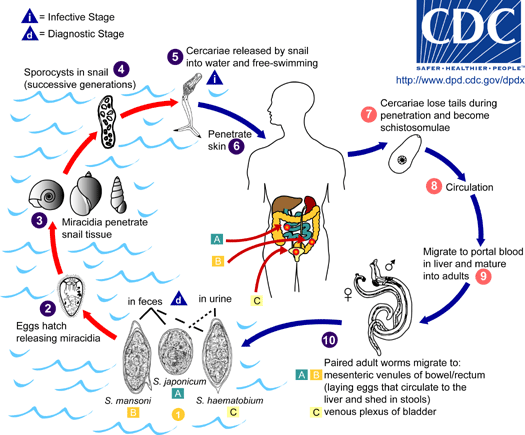Schistosomiasis is a parasitic disease caused by various species of trematodes or "flukes," which are of the genus Schistosoma. For parasites categorized as schistosomes, the snail is the intermediary agent between the mammalian hosts.
Schistosomiasis is common in countries that lack the facilities to maintain proper water supplies and sanitation facilities. These supplies and facilities are often exposed to contaminated water that contains infected snails. Individuals infected with schistosomiasis display chronic illness that can result in the damage of internal organs and in children, targets growth and cognitive development. Children will often acquire the disease by swimming or playing in contaminated water. Upon contact with contaminated water, the parasitic larvae can penetrate the skin and mature within the organ tissues.
The life cycle of the various human schistosomes is similar. The parasitic eggs are released into the environment from already-infected individuals and hatch on contact with water, releasing free-swimming miracidia. These infect freshwater snails by penetrating their skin. The site of penetration will promote the transformation of the miracidium into a primary sporocyst. This contains germ cells which will divide to produce secondary sporocysts. In turn, these migrate to the snails' hepatopancreas and the germ cells, now present within the secondary sporocysts, will divide to form thousands of new parasites called cercariae. These are the larvae capable of infecting mammals.

Schistosome Life Cycle
Overview of Schistosome generalized life cycle.
Interestingly, the cercariae are released from the snail host in a circadian rhythm and depend on ambient temperature and light. Penetration of the human skin occurs after the cercariae have attached to and explored the skin. The parasite secretes enzymes that break down the skin's protein to enable penetration of the cercarial head through the skin. As the cercaria penetrates the skin, it transforms into a migrating schistosomulum stage.
The various species which can infect humans include:
- Schistosoma mansoni, Schistosoma intercalatum: cause intestinal schistosomiasis
- Schistosoma haematobium: causes urinary schistosomiasis
- Schistosoma japonicum, Schistosoma mekongi: cause Asian intestinal schistosomiasis
- Avian schistosomiasis species: cause swimmer's itch and clam digger itch